The AMD A8-7650K APU Review, Also New Testing Methodology
by Ian Cutress on May 12, 2015 10:00 AM ESTGaming Benchmarks: Mid-Range
Alien: Isolation
If first person survival mixed with horror is your sort of thing, then Alien: Isolation, based off of the Alien franchise, should be an interesting title. Developed by The Creative Assembly and released in October 2014, Alien: Isolation has won numerous awards from Game Of The Year to several top 10s/25s and Best Horror titles, ratcheting up over a million sales by February 2015. Alien: Isolation uses a custom built engine which includes dynamic sound effects and should be fully multi-core enabled.
For low end graphics, we test at 720p with Ultra settings, whereas for mid and high range graphics we bump this up to 1080p, taking the average frame rate as our marker with a scripted version of the built-in benchmark.
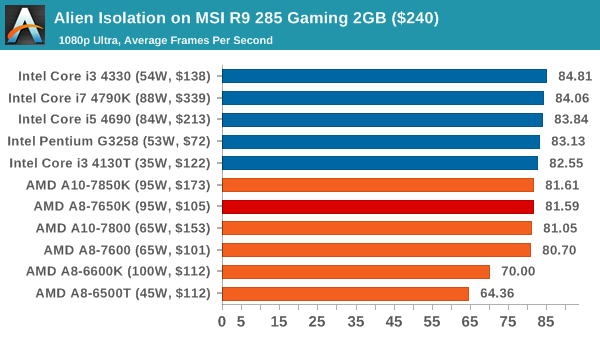
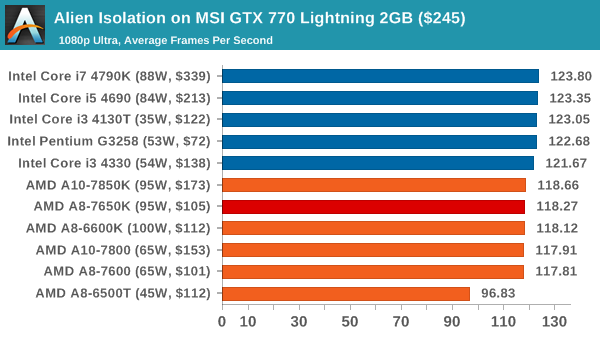
For mid range cards, Alien Isolation has a direct split for Intel and AMD, but the difference is a few FPS at best. It would seem that cores matter not here.
Total War: Attila
The Total War franchise moves on to Attila, another The Creative Assembly development, and is a stand-alone strategy title set in 395AD where the main story line lets the gamer take control of the leader of the Huns in order to conquer parts of the world. Graphically the game can render hundreds/thousands of units on screen at once, all with their individual actions and can put some of the big cards to task.
For low end graphics, we test at 720p with performance settings, recording the average frame rate. With mid and high range graphics, we test at 1080p with the quality setting. In both circumstances, unlimited video memory is enabled and the in-game scripted benchmark is used.
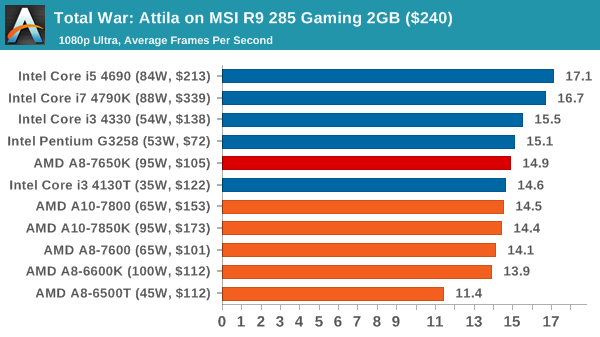
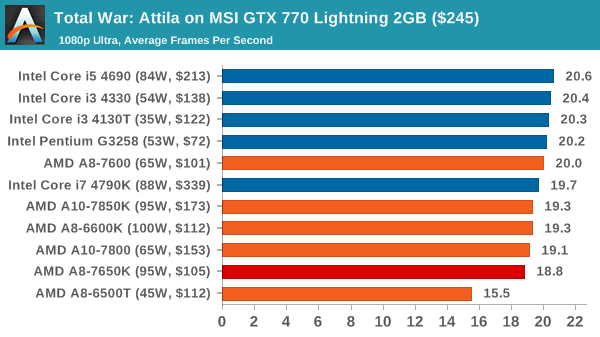
Neither combination here pulls Attila into a reasonable gaming rate, although there are bigger differences using the R9 285 GPU.
Grand Theft Auto V
The highly anticipated iteration of the Grand Theft Auto franchise finally hit the shelves on April 14th 2015, with both AMD and NVIDIA in tow to help optimize the title. GTA doesn’t provide graphical presets, but opens up the options to users and extends the boundaries by pushing even the hardest systems to the limit using Rockstar’s Advanced Game Engine. Whether the user is flying high in the mountains with long draw distances or dealing with assorted trash in the city, when cranked up to maximum it creates stunning visuals but hard work for both the CPU and the GPU.
For our test we have scripted a version of the in-game benchmark, relying only on the final part which combines a flight scene along with an in-city drive-by followed by a tanker explosion. For low end systems we test at 720p on the lowest settings, whereas mid and high end graphics play at 1080p with very high settings across the board. We record both the average frame rate and the percentage of frames under 60 FPS (16.6ms).
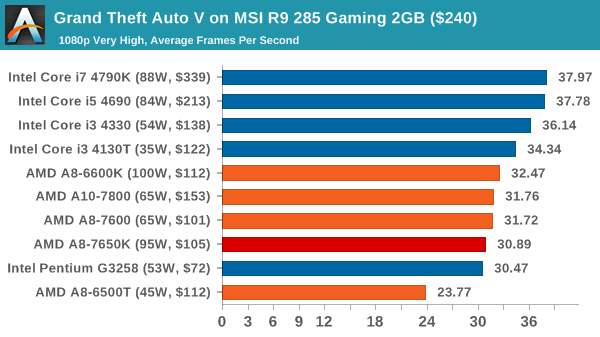
![Grand Theft Auto V on MSI R9 285 Gaming 2GB ($240) [Under 60 FPS]](https://images.anandtech.com/graphs/graph9217/74236.png)

![Grand Theft Auto V on MSI GTX 770 Lightning 2GB ($245) [Under 60 FPS]](https://images.anandtech.com/graphs/graph9217/74246.png)
On GTA, the G3258, the i3-4130T and the A8-7650K perform similarly, within a few frames of each other. Though in both circumstances the $200+ CPUs give the peak performance, up to 20% more than the $100 set.
GRID: Autosport
No graphics tests are complete without some input from Codemasters and the EGO engine, which means for this round of testing we point towards GRID: Autosport, the next iteration in the GRID and racing genre. As with our previous racing testing, each update to the engine aims to add in effects, reflections, detail and realism, with Codemasters making ‘authenticity’ a main focal point for this version.
GRID’s benchmark mode is very flexible, and as a result we created a test race using a shortened version of the Red Bull Ring with twelve cars doing two laps. The car is focus starts last and is quite fast, but usually finishes second or third. For low end graphics we test at 1080p medium settings, whereas mid and high end graphics get the full 1080p maximum. Both the average and minimum frame rates are recorded.
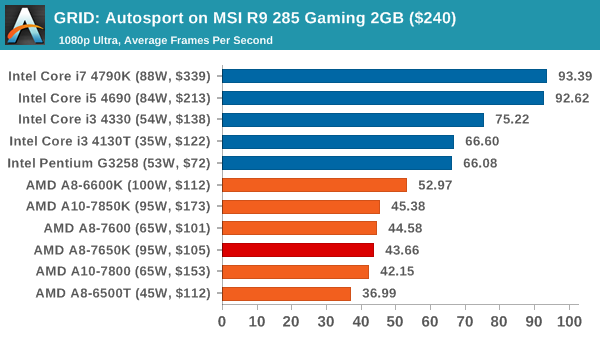
![GRID: Autosport on MSI R9 285 Gaming 2GB ($240) [Minimum FPS]](https://images.anandtech.com/graphs/graph9217/74238.png)

![GRID: Autosport on MSI GTX 770 Lightning 2GB ($245) [Minimum FPS]](https://images.anandtech.com/graphs/graph9217/74248.png)
GRID on an R9 285 seems to love Intel and loves more cores, as shown by the jump from the i3 to the i5. Whereas on a GTX 770, both teams perform similarly, well north of 60 FPS, although the difference lies more in the minimum frame rates.
Middle-Earth: Shadows of Mordor
The final title in our testing is another battle of system performance with the open world action-adventure title, Shadows of Mordor. Produced by Monolith using the LithTech Jupiter EX engine and numerous detail add-ons, SoM goes for detail and complexity to a large extent, despite having to be cut down from the original plans. The main story itself was written by the same writer as Red Dead Redemption, and it received Zero Punctuation’s Game of The Year in 2014.
For testing purposes, SoM gives a dynamic screen resolution setting, allowing us to render at high resolutions that are then scaled down to the monitor. As a result, we get several tests using the in-game benchmark. For low end graphics we examine at 720p with low settings, whereas mid and high end graphics get 1080p Ultra. The top graphics test is also redone at 3840x2160, also with Ultra settings, and we also test two cards at 4K where possible.
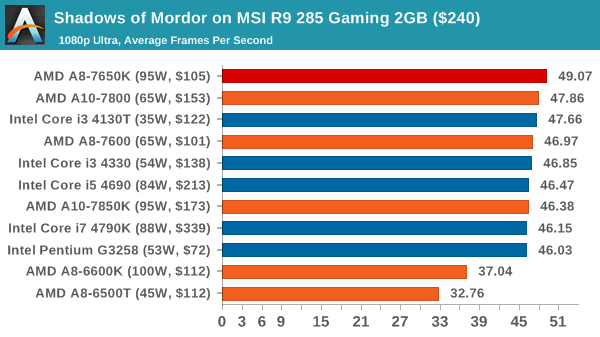
![Shadows of Mordor on MSI R9 285 Gaming 2GB ($240) [Minimum FPS]](https://images.anandtech.com/graphs/graph9217/74240.png)
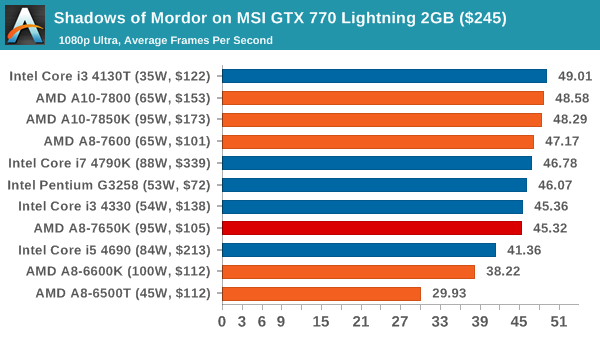
![Shadows of Mordor on MSI GTX 770 Lightning 2GB ($245) [Minimum FPS]](https://images.anandtech.com/graphs/graph9217/74250.png)
Interestingly the APUs so well at 1080p SoM, especially in average frame rates. Unfortunately this does not translate well in minimum frame rates.
Middle-Earth: Shadows of Mordor at 4K
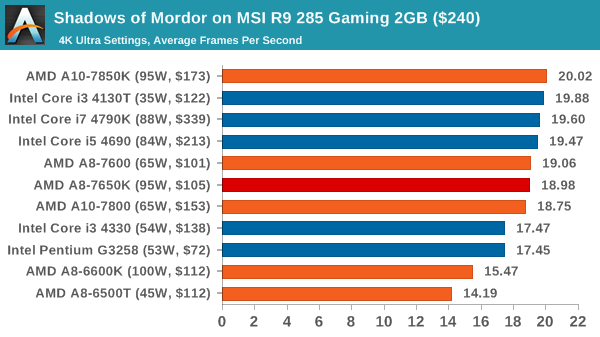
![Shadows of Mordor on MSI R9 285 Gaming 2GB ($240) [Minimum FPS]](https://images.anandtech.com/graphs/graph9217/74240.png)
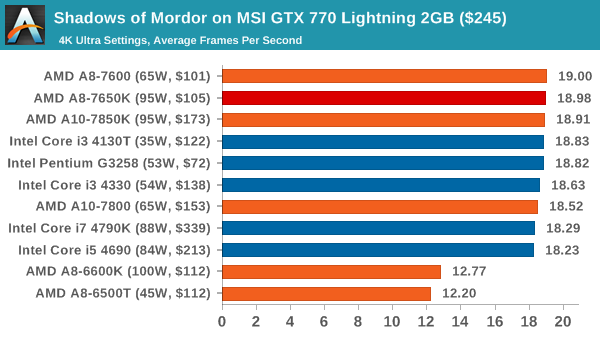
![Shadows of Mordor on MSI GTX 770 Lightning 2GB ($245) [Minimum FPS]](https://images.anandtech.com/graphs/graph9217/74252.png)
At 4K, the older 6000 series APUs seem to be a little behind. With the R9 285 there is also a staggered affect in average FPS performance, although a clear definition in minimum frame rates.















177 Comments
View All Comments
Sejong - Tuesday, May 12, 2015 - link
No comments. That just states AMD`s current position.bumble12 - Tuesday, May 12, 2015 - link
Well, if you post a minute or two after the review goes live, what might you expect exactly?YuLeven - Tuesday, May 12, 2015 - link
I think you'll find that he said "no comments" as in "no comments about AMD's poor performance", not as in "there aren't comments on this review" pal.anandreader106 - Tuesday, May 12, 2015 - link
....not sure if serious....or trolling....DevilSlayerWizard - Tuesday, May 12, 2015 - link
I would prefer if AMD made a quad core Zen with ''atleast'' 1024 GCN cores, whatever memory subsystem needed to feed the chip including RAM and motherboard for less than 500$ in 2016. Pretty reasonable if you ask me.barleyguy - Tuesday, May 12, 2015 - link
The PS4 processor, which AMD makes, is an R9-280 with an 8 core CPU. The problem is that it would be memory limited quite badly on a PC motherboard. In the PS4 it's paired with very fast memory.Possibly when AMD goes to DDR4 their APUs will start to shine, and they'll have the memory bandwidth to go wider on the GPU.
extide - Tuesday, May 12, 2015 - link
No, it's not. It is roughly between an R7 265 and R9 270 -- not anywhere near an R9 280.ravyne - Tuesday, May 12, 2015 - link
Its not a 280 -- Its got 20 GPU clusters only for 1280 shader lanes, two clusters are there for yield purposes and 4 more are dedicated to compute tasks. It has only 896 shaders dedicated to graphics, and and 256 for compute (though some engines leverage compute during rendering, so the line is a bit fuzzy). The PS4 has a 512bit memory bus, which is really wide for the GPU power, but its also feeding CPU compute. Its got 8 ACES like the 290/X.The 280 fully unlocked has 32 clusters for 2048 shaders. A 280/X has a 256bit GDDR5 bus, and only 2 ACES.
What's in the PS4 is also custom-extended beyond any retail GPU, but the closest thing would be like a Hawaii (290/X) or Tonga (285), but cut down to 18 clusters.
Revdarian - Wednesday, May 13, 2015 - link
The ps4 doesn't have 256 shaders for compute only, it has 1280 shaders total and that is it, how you decide to divide the workload for your engine is up to you, what you are thinking of was totally taken out of the context of it being an example of how to use the tools provided to the developers.nikaldro - Saturday, May 16, 2015 - link
Ps4 has 1152